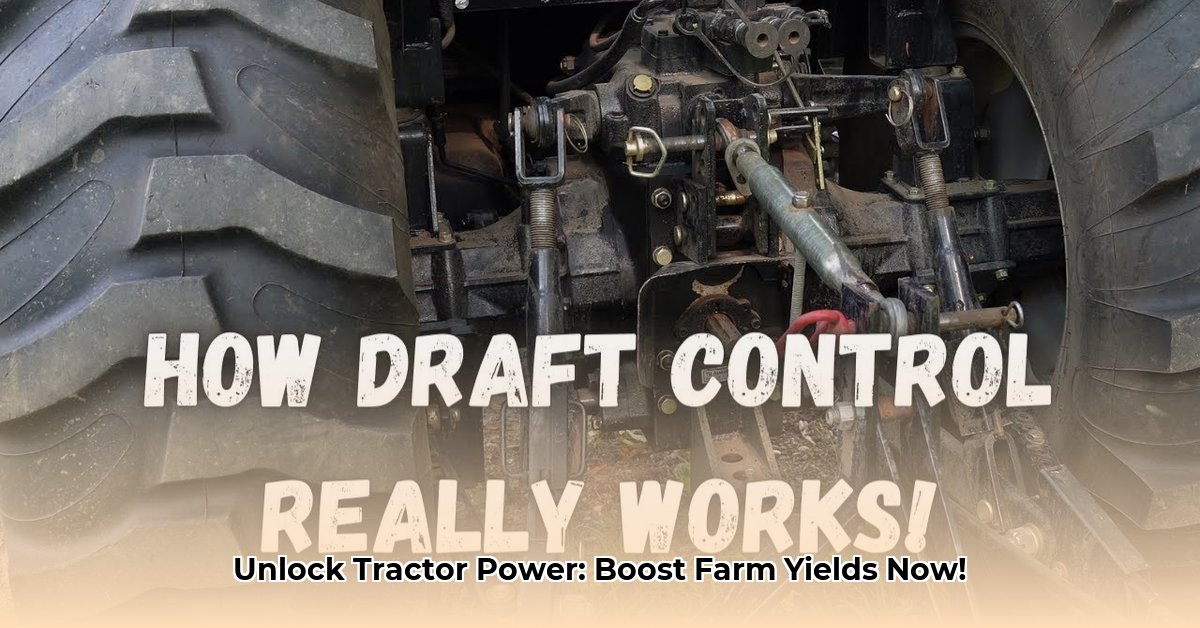
Draft Control on a Tractor: Your Guide to Effortless Farming
Want to maximize your farm's efficiency, reduce fuel costs, and improve soil health? Mastering tractor draft control is the key. This comprehensive guide explains how to effectively utilize your tractor's draft control system, regardless of your experience level. We'll cover the fundamentals, calibration techniques for diverse conditions, troubleshooting, and integration with precision agriculture technologies. Let's transform your tractor from a powerful machine into a precision instrument. For even more in-depth information, check out this helpful resource.
Understanding Draft Control: The Smart Assistant in Your Tractor
Draft control automatically adjusts your tractor's power output based on the resistance it encounters from the attached implement (e.g., plow, planter). It's like having an intelligent assistant constantly monitoring and optimizing your tractor's performance. Why is this crucial? Consistent implement depth is paramount for uniform planting, better seed germination, higher yields, and reduced soil compaction. This translates to significant cost savings in fuel, labor, and equipment maintenance. Isn't consistent, efficient operation a worthwhile goal?
Types of Draft Control Systems: Finding the Right Fit for Your Farm
Several draft control systems cater to different needs and farm sizes. Let's examine the most common types:
Position Control: This system maintains a pre-set implement depth regardless of soil resistance. Ideal for consistent depth requirements, but may struggle with severely varying soil conditions.
Draft Control: This method regulates power output based on the implement's pull. The tractor works harder when resistance increases and eases up when it decreases. It excels at adapting to changing conditions, minimizing power fluctuations. This reduces stress on the equipment and improves fuel efficiency.
Integrated Control (Mixed Systems): These systems combine the strengths of position and draft control. They offer the precision of position control with the adaptability of draft control, making them highly versatile.
The optimal system depends upon your farming practices, implement types, and soil characteristics. Expert advice tailored to your specific conditions is always recommended.
Calibrating Your Draft Control System: A Step-by-Step Guide
Proper calibration is crucial for maximizing efficiency. This process ensures optimal implement depth and minimizes wasted effort. Here's a step-by-step guide:
Step 1: Preparation: Securely attach the implement to the three-point hitch, lubricate all connections according to the owner's manual, and review the manual for initial settings recommendations.
Step 2: Initial Settings: Begin with the manufacturer's recommended settings for your specific implement and soil type. These provide a baseline for fine-tuning.
Step 3: Test Run: Choose a uniform area of your field to conduct an initial test run. This allows you to establish a baseline before moving to more variable terrain.
Step 4: Fine-Tuning: Monitor implement depth carefully and make incremental adjustments to the draft and position controls. Aim for consistent depth throughout the test area.
Step 5: Refinement and Adaptation: Move to areas with varying soil conditions and continue to fine-tune settings to maintain the target depth. Remember, consistent depth leads to better yields.
Troubleshooting: When Things Don't Go as Planned
Even with meticulous calibration, problems can occur. Here's a guide for troubleshooting common issues:
| Problem | Possible Cause(s) | Solution |
|---|---|---|
| Inconsistent Implement Depth | Incorrect calibration, worn linkage components, hydraulic leaks | Recalibrate, inspect/replace worn parts, check hydraulic system |
| Implement Stalling | Excessive resistance (depth too great), insufficient power | Reduce depth/implement width, consider a larger tractor |
| Hydraulic Leaks | Damaged hydraulic lines or seals | Repair or replace damaged components, consult a mechanic |
| Erratic Behavior | Electrical wiring issues, faulty sensors | Check wiring, connectors; replace faulty sensors |
Always consult your tractor's manual for manufacturer-specific guidance. For complex issues, seek professional assistance.
Integrating Draft Control with Precision Farming Technologies
Modern draft control systems often integrate with GPS and other precision agriculture technologies. This enables automated steering, variable-rate application of inputs (fertilizers, pesticides), and enhanced data collection. This technology can significantly boost efficiency and sustainability.
Advanced Techniques and Optimization: Fine-Tuning for Maximum Efficiency
Mastering draft control involves continuous learning and adaptation. Experimentation is key to optimizing your settings for specific field conditions and implements. Prioritize soil health and minimize soil disturbance for long-term sustainability.
Maintaining and Servicing Your Draft Control System: A Preventative Approach
Regular maintenance is crucial for longevity and preventing costly repairs. This includes checking fluid levels, inspecting hoses and connections for leaks, and keeping the system clean. A little preventive maintenance goes a long way. Did you know that regular maintenance can reduce downtime by up to 90%?
Calculating ROI: A Practical Guide
Determining the return on investment (ROI) for a tractor draft control system depends on several factors. Consider:
- Reduced Fuel Consumption: Analyze fuel savings per acre based on consistent implement depth.
- Increased Productivity: Calculate time saved per season, based on more efficient operation.
- Improved Yields: Evaluate yield increases in bushels per acre due to uniform planting/tillage.
- Reduced Equipment Repair: Estimate cost savings from lessened equipment stress.
By comparing the initial investment (including installation and maintenance) to these long-term benefits, you can accurately calculate your ROI and determine whether updating your system offers a sound financial investment. Remember, a well-maintained system saves over time.